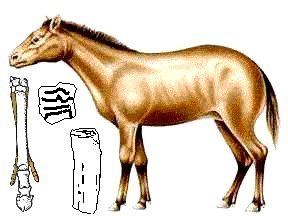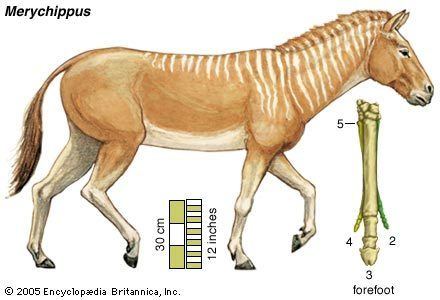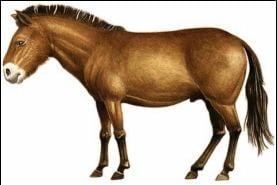Rank Genus | Scientific name Merychippus Order Odd-toed ungulate | |
 | ||
Similar Mesohippus, Pliohippus, Miohippus, Hyracotherium, Parahippus | ||
Merychippus is an extinct proto-horse of the family Equidae that was endemic to North America during the Miocene from 20.43—10.3 Ma living for approximately 10.13 million years.
Contents

It had three toes on each foot and is the first horse known to have grazed. Its name means "ruminant horse", but current evidence does not support Merychippus ruminating.

Taxonomy

Merychippus was named by Leidy (1856). Numerous authors around the turn of the century put the type species in Protohippus, but this is ignored. Its type is Merychippus insignis. It was assigned to Equidae by Leidy (1856) and Carroll (1988); and to Equinae by MacFadden (1998) and Bravo-Cuevas and Ferrusquía-Villafranca (2006).
Body mass
Four specimens were examined by M. Mendoza, C. M. Janis, and P. Palmqvist for body mass. The results were:
Description

Merychippus lived in herds. It was about 89 cm (35 in) tall; at the time it was the tallest equine to have existed. The muzzle was longer, the jaw deeper, and the eyes wider apart than any other horse-like animal to date. The brain was also much larger, making it smarter and more agile. Merychippus was the first equine to have the distinctive head of today's horses.
The foot was fully supported by ligaments, and the middle toe developed into a hoof, which did not have a pad on the bottom. In some Merychippus species, the side toes were larger, whereas in others, they had become smaller and only touched the ground when running. Its teeth were like those of Parahippus; the extra crest that was variable in Miohippus was permanent in Merychippus, and the other teeth were beginning to form a series of tall crests with higher crowns.
Descendants
By the end of the Miocene era, Merychippus was one of the first quick grazers. It gave rise to at least nineteen different species of grazers, which can be categorized into three major groups. This burst of diversification is often known as the "Merychippine radiation."
The first was a series of three-toed grazers known as hipparions. These were very successful and split into four genera and at least sixteen species, including small and large grazers and browsers with large and elaborate facial fossae. The second was a group of smaller horses, known as protohippines, which included Protohippus and Calippus. The last was a line of "true equines" in which the side toes were smaller than those of other proto-horses. In later genera, these would be lost altogether as a result of the development of side ligaments that helped stabilize the middle toe during running.
